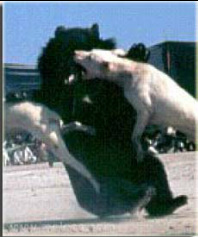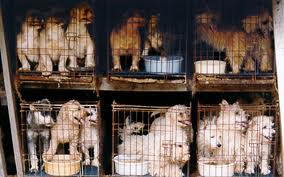|
|
Animal Cruelty
Signs That an Animal Might Be Abused Recognizing cruelty is simple, right? Not quite, say SPCA experts. Aggressive, timid or fearful behavior doesn't always tell the whole story. Animals may appear to be timid or frightened for many reasons other than abuse.
“It’s almost impossible to make conclusions based on a pet’s behavior alone,” says the CCC Animal Behavior Center’s Justin Gill. “The best way to tell whether a pet is being or has been abused is to examine him and his surrounding environment.” Check out our list of signs that may alert you an animal needs help: Physical Signs
Environmental Signs
If you see signs of animal abuse, don’t keep it to yourself. Report it to the S.P.C.A. in your area. What Is the Impact of Animal Cruelty? Animals feel pain and fear like we do, but they are often helpless victims because they can't say what happened to them. In fact, some people choose to abuse animals instead of people for this very reason! If we wish to create a humane society, we must stop cruelty against those who are most vulnerable-like animals. Cruelty toward animals does more than cause other living, feeling beings to experience pain and fear— violence toward animals can be an indicator that people are also in danger. Someone who commits animal abuse may have serious psychological problems. Studies have found that many people convicted of violent crimes had a history of animal cruelty. Jeffrey Dahmer, Ted Bundy, Andrew Cunanan, David "Son of Sam" Berkowitz, and Albert "Boston Strangler" DeSalvo were cruel to animals before they started hurting people. Adults are not the only ones whose cruelty to animals can be a sign of deeper troubles. Why is Humane Education Important? One of the most powerful tools we have for preventing cruelty to animals is education. It is important to plant the seeds of kindness in children early, and to nurture their development as the child grows. Children not only need to learn what they shouldn't do, but also what they can do. When children see that their pets are happy and loving, it will make the child feel good, too. This in turn will help the children care for their pets' feelings. Children need proper education, too. Please urge your local schools to integrate humane education into their curricula. To help you, your local shelter may have outreach programs, education materials, camps, etc. You can also find plenty of humane ideas and activities on children's website, ASPCA Kids. Discussing Animal Cruelty with Children Under Six Every child is unique, and adults should use caution and careful thought when discussing cruelty with children. In general, children under four simply should not be exposed to cruelty. Two-year-olds can begin to learn that their actions make others-including animals-happy and sad. With two- and three-year-olds, discuss their own experiences and how they would feel if they were treated the way they treat their pets or other animals in their immediate lives. Help them relate not only the ways they would feel hurt, but also the ways they would feel happy. With all children under six or so, you may wish to help guide their hands so they can learn how to pet and hold their animal companions. Children do not have fine control over their movements and impulses—they will want to treat their pets with love, but will need a little help from you to do it correctly. Children who are between about four and six often begin to understand basic moral concepts, such as fairness. These children can learn to be kind to animals because the animals "deserve" it. Children may discuss injuries they have had themselves, but do not introduce discussions about other types of injuries. Try to limit discussions of animal cruelty to the simple fact that animals can be hurt; do not describe how they can be hurt (e.g., starvation, physical abuse, etc.). Discussing Animal Cruelty with Children Ages Six to Ten With most children who are six to ten years old, you can begin to discuss why someone might be mean to an animal-as long as you make sure the child always keeps in mind that it is wrong to hurt animals. In addition, do not let discussions of animal cruelty satisfy the morbid curiosity some children of this age may have. Children of this age often form some of their earliest memories and impressions about the state of the world beyond their families. It is very important that adults filter what these children perceive! Even if children witness violence as a "bad example" or as a way NOT to act, they are still witnessing violence, and can be strongly affected by it. Discussing Animal Cruelty with Children Ages 10 to 14 Many children between 10 and 14 are exploring their self-image and reflecting upon their relationships with others. Studies indicate that children of this age are still strongly affected by violence, so discussions about animal cruelty should still be kept free of details about the violence. Nonetheless, the issue can be raised directly—if delicately—with most of these children. Adults should make it clear that they do not condone violence in their own thoughts and behavior. Children of this age are finely attuned to the words and actions of adults, and still rely on them as role models. Parents, teachers, and trusted adults can also discuss with 10- to 14-year-olds how they would act if their peers or friends treated animals cruelly. By couching the advice in terms of what you would do if you were in a given situation, you can help children overcome peer pressure and follow what they know is right. These children may encounter others abusing animals—knowing that they are in the right and will be supported for standing up to it is very important at this age of strong peer pressure. Discussing Animal Cruelty with Older Children and Teens Again, with all children-even older teens-keep in mind the importance of modeling appropriate behaviors. Our children do emulate us, even if they wouldn't admit it. If we treat animals cruelly or as unfeeling machines, our children will probably think that this is right or, at least, normal. The more a child identifies with an adult, the greater an impact that person will have on the child-in both good ways and bad ways. Children who know of animal cruelty should tell an adult about it. Make sure children know who they can trust—such as parents, teachers, police officers, etc.—and nurture their trust so they can tell you. |
|


